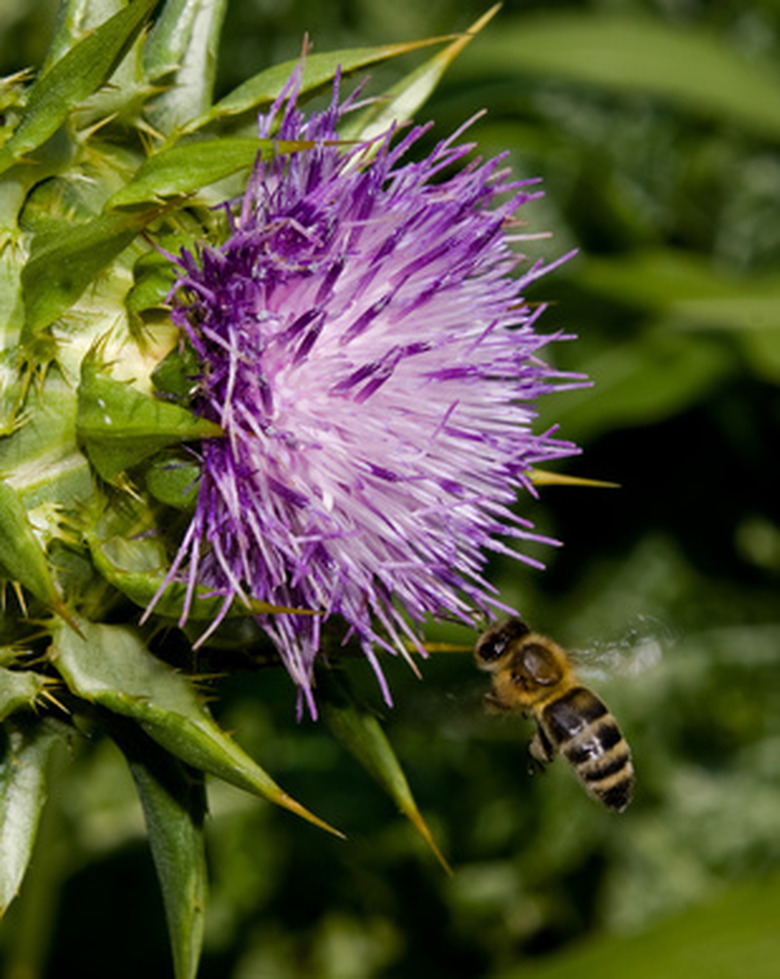Milkweed & Milk Thistle
They might share similar names and status as wildflowers, but milkweed and milk thistle (also called blessed milk thistle) are actually quite different. The two plants have similarities in height and growth and differences in uses. One plant has extensive medicinal properties while the other is toxic if ingested. Both plants are attractive to wildlife. Both milk thistle and milkweed are often considered noxious weeds by many.
Varieties
Milkweed (Asclepias) has a variety of species in the wild. There is common milkweed, swamp milkweed, butterfly weed (or butterfly milkweed), showy milkweed, scarlet milkweed and more.
- They might share similar names and status as wildflowers, but milkweed and milk thistle (also called blessed milk thistle) are actually quite different.
- Milkweed (Asclepias) has a variety of species in the wild.
Milk thistle (Silybum marianum) is not a close relative to other common thistle plants like bull thistle and musk thistle.
Growth Requirements
Both milk thistle and milkweed prefer full sun for best growth. Both plants grow well in any soil type, even soil that is rocky and dry. Both plants will grow in low water conditions. Both milkweed and milk thistle can be found growing along roadsides, in fields, ditches and other similar locations.
Medicinal Uses
Milk thistle is known for having a number of medicinal properties and has been medicinally for about 2,000 years. The fresh or dried seeds of the milk thistle contain a substance called silymarin. Silymarin aids in blocking toxins from entering liver cells. Milk thistle has been used to treat upset stomach, liver and gallbladder ailments.
- Milk thistle (Silybum marianum) is not a close relative to other common thistle plants like bull thistle and musk thistle.
- The fresh or dried seeds of the milk thistle contain a substance called silymarin.
Milkweed is actually toxic to most animals and humans. The plant contains compounds, which are called cardenolides. Cardenolides cause heart palpitations in both humans and animals.
Culinary Use
Milk thistle stalks can be boiled and eaten like other vegetables. Young leaves can be used as salad greens and the root of the milk thistle plant is also edible. Seeds can be roasted and ground for use as a coffee substitute.
Milkweed is inedible because of the cardenolides in the plant and does not have a culinary use.
- Milkweed is actually toxic to most animals and humans.
- Milkweed is inedible because of the cardenolides in the plant and does not have a culinary use.
Wildlife
Milkweed and milk thistle are both attractive plants to wildlife. Both are considered nectar plants for butterflies and many different butterfly species can be found feeding from the flower heads of these two plants.
Milkweed is the larval host for the monarch butterfly and the milkweed tussock moth. Milk thistle attracts butterflies like the American painted lady butterfly. Birds like the American goldfinch will also nest in thistle plants and feed upon the seed heads.
Other Uses
Milkweed plants have been used historically by Native Americans. The milky sap of the milkweed plant was used as an adhesive while the stringy stalks were used as cordage. The fibers found inside milkweed pods have been used as filling for items like life jackets and comforters and more.
- Milkweed and milk thistle are both attractive plants to wildlife.
- Both are considered nectar plants for butterflies and many different butterfly species can be found feeding from the flower heads of these two plants.
Milkweed oil is free of cardenolides and rich in vitamin E. Milkweed oil has been used in skin moisturizers. The seedmeal of milkweed, which cannot be used in animal feed, has been found to be effective in pest control. The seedmeal kills nematodes and fall armyworms. These pests are destructive to tomatoes, potatoes, alfalfa, sorghum, soybeans, corn and peanuts.
Milk thistle is popular among the medicinal herb market. Many natural health practitioners recommend milk thistle seeds for improved health.
